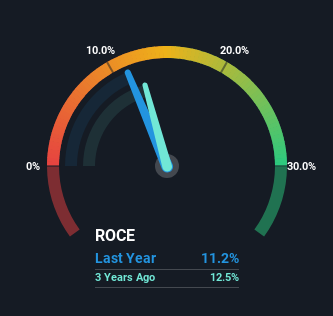- India
- /
- Oil and Gas
- /
- NSEI:AEGISLOG
Some Investors May Be Worried About Aegis Logistics' (NSE:AEGISLOG) Returns On Capital
If you're looking for a multi-bagger, there's a few things to keep an eye out for. Firstly, we'll want to see a proven return on capital employed (ROCE) that is increasing, and secondly, an expanding base of capital employed. Put simply, these types of businesses are compounding machines, meaning they are continually reinvesting their earnings at ever-higher rates of return. However, after briefly looking over the numbers, we don't think Aegis Logistics (NSE:AEGISLOG) has the makings of a multi-bagger going forward, but let's have a look at why that may be.
Return On Capital Employed (ROCE): What Is It?
If you haven't worked with ROCE before, it measures the 'return' (pre-tax profit) a company generates from capital employed in its business. To calculate this metric for Aegis Logistics, this is the formula:
Return on Capital Employed = Earnings Before Interest and Tax (EBIT) ÷ (Total Assets - Current Liabilities)
0.11 = ₹7.9b ÷ (₹81b - ₹10b) (Based on the trailing twelve months to March 2024).
So, Aegis Logistics has an ROCE of 11%. In isolation, that's a pretty standard return but against the Oil and Gas industry average of 14%, it's not as good.
See our latest analysis for Aegis Logistics

Above you can see how the current ROCE for Aegis Logistics compares to its prior returns on capital, but there's only so much you can tell from the past. If you're interested, you can view the analysts predictions in our free analyst report for Aegis Logistics .
What Does the ROCE Trend For Aegis Logistics Tell Us?
On the surface, the trend of ROCE at Aegis Logistics doesn't inspire confidence. Around five years ago the returns on capital were 19%, but since then they've fallen to 11%. And considering revenue has dropped while employing more capital, we'd be cautious. This could mean that the business is losing its competitive advantage or market share, because while more money is being put into ventures, it's actually producing a lower return - "less bang for their buck" per se.
On a related note, Aegis Logistics has decreased its current liabilities to 13% of total assets. That could partly explain why the ROCE has dropped. Effectively this means their suppliers or short-term creditors are funding less of the business, which reduces some elements of risk. Since the business is basically funding more of its operations with it's own money, you could argue this has made the business less efficient at generating ROCE.
Our Take On Aegis Logistics' ROCE
From the above analysis, we find it rather worrisome that returns on capital and sales for Aegis Logistics have fallen, meanwhile the business is employing more capital than it was five years ago. Since the stock has skyrocketed 339% over the last five years, it looks like investors have high expectations of the stock. Regardless, we don't feel too comfortable with the fundamentals so we'd be steering clear of this stock for now.
One more thing: We've identified 2 warning signs with Aegis Logistics (at least 1 which is significant) , and understanding these would certainly be useful.
For those who like to invest in solid companies, check out this free list of companies with solid balance sheets and high returns on equity.
New: Manage All Your Stock Portfolios in One Place
We've created the ultimate portfolio companion for stock investors, and it's free.
• Connect an unlimited number of Portfolios and see your total in one currency
• Be alerted to new Warning Signs or Risks via email or mobile
• Track the Fair Value of your stocks
Have feedback on this article? Concerned about the content? Get in touch with us directly. Alternatively, email editorial-team (at) simplywallst.com.
This article by Simply Wall St is general in nature. We provide commentary based on historical data and analyst forecasts only using an unbiased methodology and our articles are not intended to be financial advice. It does not constitute a recommendation to buy or sell any stock, and does not take account of your objectives, or your financial situation. We aim to bring you long-term focused analysis driven by fundamental data. Note that our analysis may not factor in the latest price-sensitive company announcements or qualitative material. Simply Wall St has no position in any stocks mentioned.
Have feedback on this article? Concerned about the content? Get in touch with us directly. Alternatively, email editorial-team@simplywallst.com
About NSEI:AEGISLOG
Aegis Logistics
Operates as an oil, gas, and chemical logistics company primarily in India.
Flawless balance sheet with proven track record.
Similar Companies
Market Insights
Community Narratives



